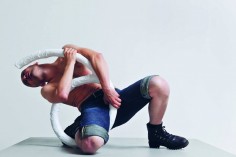FRANZ WEST
프란츠 웨스트
Франц Вест
פרנץ מערב
フランツ·ウェスト
I-on
source: gagosian
Franz West was born in Vienna in 1947 and studied at the Academy of Applied Arts, Vienna. He died in Vienna in July 2012. West’s work has been a fixture in countless international survey exhibitions such as Documenta and Biennales all over the world, and it is included in major public collections including Centre Pompidou, Paris; Museum Ludwig, Cologne, the Museum of Modern Art, New York; and MAXXI, Rome. Recent solo exhibitions include “We’ll Not Carry Coals,” Kunsthaus Bregenz, Austria (2003); “Recent Sculptures”, Lincoln Center, New York (2004); Vancouver Art Gallery (2005); MAK, Vienna (2008); “To Build A House You Start with the Roof: Work, 1972–2008,” Baltimore Museum of Art (2008–09, traveled to Los Angeles County Museum of Art in 2009); and “Franz West: Autotheater,” Museum Ludwig, Cologne (2010, traveled to MADRE, Naples and Universalmuseum, Graz, Austria in 2010–11).
.
.
.
.
.
.
.
source: rogallery
Franz West lives and works in Vienna, where he was born in 1947. West began his career in mid-1960s Vienna when a local movement called Actionism was in full swing. West’s earliest sculptures, performances, and collages were a reaction to this movement, in which artists engaged in displays of radical public behavior and physical endurance meant to shake up art-world passivity. In the early 1970s, West began making a series of small, portable sculptures called “Adaptives” (“Paßtücke”), awkward-looking plaster objects that were only completed as artworks when the viewer picked them up and carried them around, or performed some other inherently slapstick action with them. In many ways, his large-scale aluminum sculptures are simply overgrown versions of the “Adaptives.” But they also relate directly to his installations, where west makes furniture. West has the ability to make comfortable and colorfully upholstered couches and chairs which transform galleries, museums, and public spaces into lounge-like, sociable environments for viewing art.
West has exhibited internationally for more than three decades in galleries and museums, and at major festivals including Documenta IX (1992) and Documenta X (1997), Kassel, Germany; Sculpture Projects in Münster (1997); and the Venice Biennale (1988, 1993, 1997, 2003). In 1997 The Museum of Modern Art presented West with a solo show. More recently West’s work has been exhibited at the Museo Nacional de Arte Reina Sofía (2001), Whitechapel Gallery, London (2003); Kunsthalle Wien, Vienna (2003); Gagosian Gallery, New York (2003); and the Galerie Eva Presenhuber, Zurich (2006). West most recent will open in September of 2006 at The Gagosian Gallery in London.
.
.
.
.
.
.
.
source: mediationcentrepompidoufr
En 2010, Franz West rencontre le performeur d’origine bulgare Ivo Dimchev (né en 1976) qui, loin d’être enfermé dans un seul mode d’expression, est aussi tout à la fois chanteur, danseur, metteur en scène, chorégraphe, photographe, plasticien et parfois vidéaste. Un tout artistique qu’il cherche à développer simultanément sur scène.
Franz West lui propose de le filmer en train de manipuler ses Adaptives. Ces vidéos, réalisées dans le but de montrer des exemples potentiels de manipulation, s’adressent avant tout aux visiteurs de ses expositions dont il trouve les gestes trop peu spontanés et convaincants. En retour, Ivo Dimchev demande à Franz West s’il peut créer un spectacle avec ses sculptures. Cette première collaboration donne lieu au solo I-ON (2010). Nu sur scène, Dimchev, dont les performances se saisissent des états limites du corps, manipule les sculptures de West, cherchant à en faire une expérience corporelle et sensorielle. Fort de ce solo, mode d’expression principal de son travail, il propose alors à West une nouvelle configuration pour un spectacle de quatre danseurs, auquel il participe.
X-ON, créé en 2011, aborde donc, non plus sur le mode du performeur unique mais de la performance collective, la question de la manipulation de l’œuvre d’art, qui n’est plus l’originale mais la copie. Ainsi, des interactions individuelles et collectives se jouent entre l’œuvre et ceux qui l’expérimentent. Si Franz West refusait la passivité du spectateur dans une exposition et devant ses œuvres, la proposition d’Ivo Dimchev, avec ses danseurs, est une invitation participative au public afin de l’engager dans une expérience de l’art hors du contexte de la galerie ou du musée.
.
.
.
.
.
.
.
source: lentaru
Франц Вест начал свою карьеру в период расцвета венского акционизма в середине 1960-х годов. Его наиболее известные работы – скульптура Flause (“Клочки”) 1998 года и Lemur Head (“Голова Лемура”), а также серия маленьких скульптур Passtuecke (“Приспосабливающиеся”). Помимо скульптур, Вест также был автором картин и инсталляций.
Работы художника регулярно были представлены на международных выставках, в том числе на венецианской арт-биеналле и на “Документе”. Вест – лауреат нескольких наград. В 2011 году он стал обладателем почетного “Золотого льва” венецианской арт-биеналле.
.
.
.
.
.
.
.
source: rgru
На 66-м году жизни скончался известный австрийский художник Франц Вест, обладатель почетного “Золотого льва” последней 54-й арт-биеннале в Венеции за вклад в искусство. Он умер в Центральной больнице Вены после продолжительной, сообщает РИА Новости со ссылкой на австрийский телеканал ORF.
Вест начинал свою карьеру в середине 1960-х, в период расцвета венского акционизма, подразумевающего стремление стереть грань между искусством и действительностью. Для этой формы искусства характерен перенос акцента с самого произведения на процесс его создания. Вест придерживался этого направления в своих ранних скульптурах, перформансах и коллажах.
В начале 1970-х художник обратил на себя внимание маленькими скульптурками – “Приспосабливающимися”, которые становились произведениями искусства только в паре со зрителем, который должен был перемещать их, держать возле себя или совершать некие действия.
Вест также создавал красочные мягкие диваны и кресла, которые трансформируют музеи и галереи в комфортабельный энвайронмент (окружающую среду).
С 1988 года Вест постоянно экспонировался на мировых выставках, в том числе на “Документе” и арт-биеннале в Венеции. В последний раз он делал для основного проекта по приглашению куратора Биче Куригер так называемый “парапавильон”, вмещающий произведения других авторов. Для реализации задуманного он решил создать вывернутую наизнанку версию собственной кухни, на стенах которой висели рисунки, записки и фотографии.


